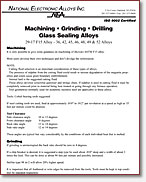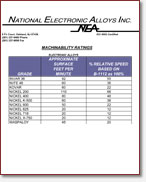 |
|
Machinability Ratings Chart & Data for Expansion AlloysNational Electronic Alloys: A Company Dedicated To Customer Service & QualityMachinabilityTypically low expansion alloys machine similar to, but not as good as a Type 316 austenitic stainless steel; or, around 25 percent as good as AISI B1112. They develop somewhat gummier and stringy chips and higher forces, but do not work harden as rapidly as Type 316. Work hardened bars can result in some improvement of the inherent machinability in some instances. Tool geometries normally used for austenitic stainless steels are applicable to these alloys. All tools should be kept sharp with a fine finish, be as large as possible and rigidly supported. Cutting fluid selection is an important consideration in the machining of low expansion alloys. For best machinability, a 1 to 1 blend of a sulfachlorinated pertroleum oil containing 8 to 10 percent fatty oil and a paraffin blending oil would be used, or a water emulsifiable cutting fluid with polar and extreme pressure additives. However, the presence of any residual sulfur from the cutting fluid on the machined part, followed by heat treating, could result in serious degradation or magnetic properties. Meticulous degreasing and cleaning of machined parts can remove sulfur residues resulting from the sulfur-bearing cutting compounds. Animal lard is also used as a cutting lubricant. In any event, the parts should be degreased and cleaned as soon after machining as possible. Residual sulfur can also cause grain boundary embrittlement.
|

